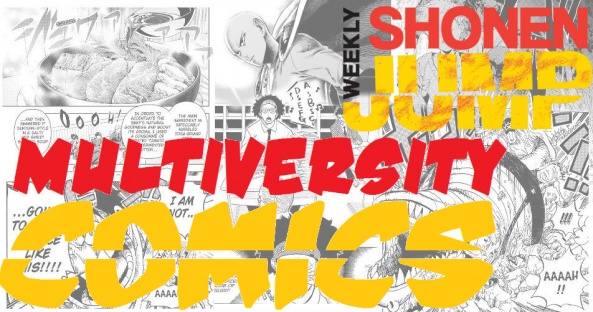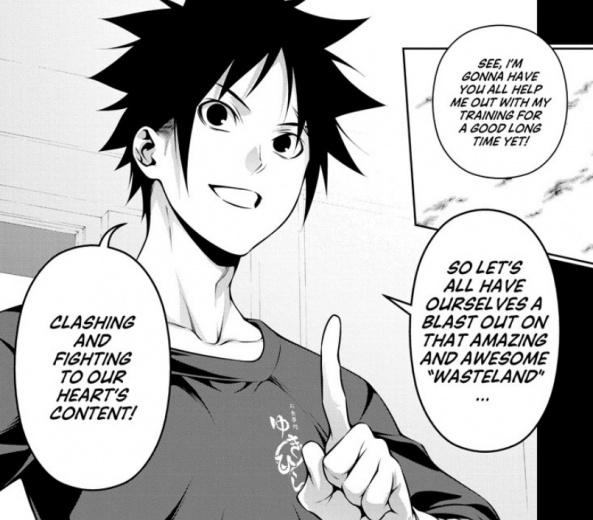
Welcome to This Week in Shonen Jump, in which a rotating duo of Multiversity staffers take a look at two stories contained in each installment of Viz Media’s Weekly Shonen Jump. For the uninitiated, Weekly Shonen Jump is an anthology that delivers more than 200 pages of manga of all varieties. We hope that you’ll join us in exploring the world of Weekly Shonen Jump each week. If you are unfamiliar, you can read sample chapters and subscribe at Viz.com.

This week, Matt and Zach check in with “The Promised Neverland” and “Food Wars.” If you have any thoughts on these titles, or “My Hero Academia,” “We Never Learn,” “Kimi Wo Shinryakuseyo,” “Robot X Laserbeam,” “Momiji No Kisetsu,” “Dr. Stone,” “One Piece,” or “Black Clover,” let us know in the comments!

The Promised Neverland Chapter 88
Written by Kaiu Shirai
Illustrated by Posuka Demizu
Reviewed by Matt Lune
This series has always been about strategy, and it’s no doubt been mentioned before how it feels like the characters are always playing a complex, psychological game of chess in every chapter. In this installment of “The Promised Neverland,” however, that comparison is made rather explicit, in a flashback that shows just how Emma became the master tactician she always appears to be, which was by learning life lessons from Ray over a chessboard.
While it may not have needed to be quite so obvious in its exposition, “The Promised Neverland” is never anything less than satisfying when it shows the heroes one step ahead of the villains, and then proceeds to flash back to just how they won themselves the advantage. Here, the battle for Goldy Pond is reaching its climax, and with only the most powerful demon Leuvis left to beat, victory seems tantalizingly close.
These last few chapters have been building the confrontation between Leuvis and Emma in a brilliant way, counting down the ten minutes he’s allowed her to fight him before he can fight back. We switch from Leuvis’s point of view, to Emma’s, to Pepe’s, all the while seeing their thoughts spilling out onto the page, guessing and second-guessing their opponent’s actions for page after page, until you realise that you’ve been totally gripped for close to eleven pages without anything actually happening in the scene itself.
The last eight pages bring the action back in a big way (not that you’ll have missed it), and ends with a fist pump of a cliffhanger, as returning characters finally enter the fray and reunite with their old friend. For a series with such a hopeless, seemingly insurmountable premise, “The Promised Neverland” has done extremely well in this latest arc to present a smart, realistically feeling (relatively speaking) rebellion against a far greater foe.
The greatest strength of this chapter is its pacing. Manga’s style always allows for a stronger sense of controlled pacing that western comics can only envy and emulate, and here it pays off extremely well. The aforementioned first half essentially shows Leuvis stalking around the village, with Emma and Pepe hiding and finding more strategic vantage points to strike. Rather than lean on physical action, the creators rely on the internal dialog and flashbacks to ramp up the tension, stressing the importance of every move and decision made. Posuka Demizu’s artwork gives Leuvis the gravitas he deserves, dominating every panel he’s in, viewing him from every angle possible, and even in one panel where he’s smaller in the scene, his presence is like a black hole that draws your eye towards him. The final shots are across a double page spread, and are the first time we see Leuvis as truly small, literally and figuratively, as the hero – seemingly getting the upper hand over the demon – takes up a full third of the image.
“The Promised Neverland” is doing a superb job of depicting survivors battling against almost unwinnable odds, doing so with cunning strategy and grand, exciting moments. It’s at times comparable to “The Walking Dead,” especially in these latest chapters: any character (apart from a core few) could be killed; there’s a constant, ongoing apocalypse that they’re fighting against; their situation is forever changing and evolving as they move forward through this world, and ultimately it’s showing a group of people doing everything they can to survive. If it keeps delivering excellent chapters like this, people will be talking about “The Promised Neverland” for a long time to come.
Continued belowFinal Verdict: 8.9 – A series that builds the tension and rewards the reader with epic confrontations. Quickly becoming a modern classic.

Food Wars Chapter 264
Written by Yuto Tsukuda
Illustrated by Shun Saeki
Contributions by Yuki Morisaki
Reviewed by Zach Wilkerson
If the last chapter of “Food Wars” felt like a series finale (it did), then this week’s installment feels very much like a “feel good” epilogue. We, the readers, reap the benefit of the resistance’s triumph over Central with an interesting and fresh new status quo. However, with such a startling shake up to the series’s foundation, one has to wonder where the story is left to go? Unfortunately, this chapter gives little hint.
We pick up four months following the team shokugeki, with Erina as the new headmaster of Totsuki, the resistance members sitting on the council of ten, and the third years graduating and moving on in their careers. The status of the school is a little shaky in the midst of a massive resolution, similar to a restructuring government after a civil war. With Soma’s declaration that his reign as first seat is up for grabs, daily shokugeki’s are the norm. This new dynamic could definitely create some interesting cook offs, which are without doubt the book’s bread and butter. However, it doesn’t seem like the book will focus on food battles so quickly after a long tournament arc.
The emphasis on actual schooling and progression feels somewhat undermined by Soma’s meteoric rise among the Council of Ten. It’s a victory too soon, as if Ash conquered the Kanto League or Naruto became Hokage midway through the series. Even so, this subversion of shonen tropes is very refreshing.
While it may feel like an ending at times, this is definitely a new beginning for the series. The transitionary nature of the chapter means that there’s more exposition that usual and no food driven antics, making for a somewhat less exciting read than readers have become accustomed to over the preceding weeks. Artistically, the chapter is stylistically as strong as ever, though the lack of action means that Saeki’s pages are fairly tame. Nevertheless, we get some great character moments from the likes of Erina, Hisako, and Megumi.
It’s a rare treat for a long running manga title to experience such a shake up as “Food Wars” is now. It’s an exciting time to be reading the book, even if the future of the series is quite unclear. The final pages of the chapter leave even more questions unanswered, but of course, we’re only a week away from another chapter.
Final Verdict: 7.0 – A competent transition chapter sets up an exciting new era for “Food Wars.”






